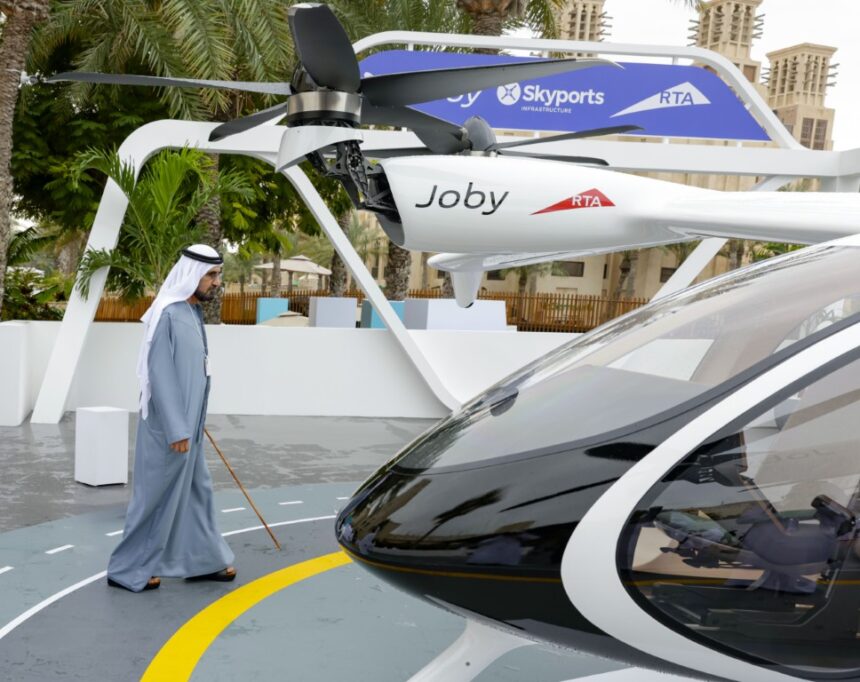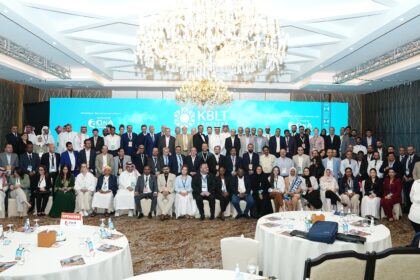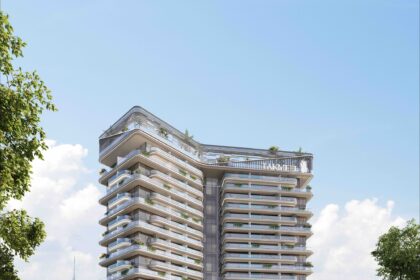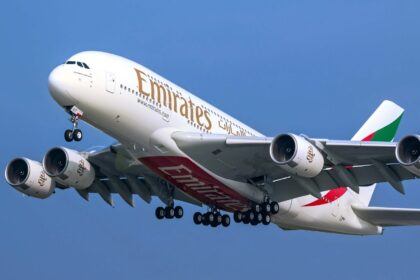The United Arab Emirates, particularly Dubai and Abu Dhabi, have long been synonymous with innovation, big builds, and forward-looking infrastructure. In keeping with that tradition, the UAE has now set its sights on transforming urban mobility through the deployment of electric vertical take-off and landing (eVTOL) air taxis. By 2026, residents and visitors in key emirates may see air taxi services that promise to slash journey times, reduce congestion, and help reinforce the UAE’s role as a global leader in advanced transportation.
This isn’t just a pilot project. It’s being built into the transportation fabric of cities, with plans for infrastructure, regulation, and operational models already underway.
Key Players & Partners
Several major entities are involved, each bringing different strengths:
- Dubai Roads and Transport Authority (RTA): Leading the Dubai initiative. Responsible for planning the vertiports, integrating the service into the existing transport network, ensuring regulatory compliance and safety, etc
- Joby Aviation: A U.S.-based company that builds electric air taxis. They’ve been granted a six-year exclusive operational agreement in Dubai for these services. Joby’s aircraft are central to the Dubai plan
- Skyports: A UK-based infrastructure company, tasked with designing and constructing the vertiports (the take-off and landing stations). They will also operate station infrastructure.
- General Civil Aviation Authority (GCAA) of UAE, with research support from organizations such as the Technology Innovation Institute (TII) and ASPIRE under the Advanced Technology Research Council (ATRC), helping with airspace regulation, corridor mapping and safety frameworks.
- Abu Dhabi Investment Office (ADIO) and Archer Aviation: Abu Dhabi is also planning its all-electric air taxi service, in collaboration with Archer Aviation.
- Ras Al Khaimah Tourism Authority (RAKTA): Also preparing for its own version of electric air taxis/eVTOL services by 2027 to connect popular tourist areas.
·
What is Being Built: Services, Aircraft, Routes, Infrastructure
Here’s what we know so far about how the UAE’s air taxi plans are being shaped:
Aircraft Characteristics & Operating Specs
- The air taxis will be fully electric eVTOLs, capable of vertical take-off and landing. Initially, they will be piloted (i.e., there will be a human pilot on board) rather than autonomous.
- Capacity: each aircraft can carry one pilot plus four passengers and luggage
- Speed & Range: They are expected to reach speeds of ~320 km/h, with ranges up to about 160–200+ km on a single charge.
- Noise & Emissions: Being electric, zero emissions during flight. Noise levels are said to be quite low — under 45 decibels in some reports, which is quieter than many helicopters.
Vertiports & Stations
Vertiports are a fundamental piece of the infrastructure. These are like special landing / take-off hubs for eVTOLs. Key details:
- Initial Four Locations in Dubai: Dubai International Airport (DXB), Palm Jumeirah, Dubai Marina, and Downtown Dubai
- Facilities will include: dedicated take-off / landing pads, charging facilities, passenger waiting / boarding areas, security arrangements.
- The first vertiport under construction is near DXB, behind the Emirates Airline building.
- Capacity: One of the first vertiports is designed to handle around 170,000 passengers per year.
Regulatory, Airspace & Corridor Mapping
- The UAE’s General Civil Aviation Authority (GCAA) is working with TII and ASPIRE to map air corridors — paths in the sky that define where air taxis and cargo drones can fly. These corridors are crucial for safety, airspace management, avoiding interference with existing aircraft, etc.
- A regulatory framework is being developed for both piloted and autonomous operations. Autonomy likely comes later.
- Infrastructure rules like “hybrid heliports” (i.e. platforms that can support both helicopters and eVTOLs) are being approved. For example, Abu Dhabi has approved its first hybrid heliport at Zayed Port, to serve as a launch point for its air taxi service.
Timeline & Phases
- 2025 – testing, mapping, regulatory groundwork, vertiport construction, prototype showings. Some early operations might start late in 2025 in limited or demonstration form.
- Q1 2026 – full commercial operations begin (in Dubai, for example) for the air taxis, with initial vertiports operational.
- 2026 onwards – building out of more networked vertiports, potentially expanding to other emirates, scaling up frequency, more routes, broader public usage, possibly lower fares as costs scale. Abu Dhabi and Ras Al Khaimah are planning similar services, though slightly offset in timing. RAK’s air taxi operations expected by 2027.
Several driving factors make air taxis particularly appealing for the UAE:
- Traffic & Congestion Relief
Cities like Dubai and Abu Dhabi face increasing road traffic, especially during peak hours. Faster alternatives for key routes (airport ⇄ downtown, etc.) can significantly reduce journey times. For example, the trip from DXB to Palm Jumeirah may drop from ~45 minutes by car to ~10-12 minutes by air taxi. - Sustainability & Environment
Electric aircraft produce zero emissions in flight, and with low noise pollution, enable more eco-friendly urban transport. The UAE has made sustainability a core part of its planning & strategy, so air taxis are aligned with its climate goals - Technological Leadership & Innovation Branding
For the UAE, being first to scale advanced air mobility is part of its global positioning. The country has often leveraged cutting-edge tech (autonomous vehicles, flying taxis, drones) as part of its image and investment climate. This draws investment, tourism, and sets standards for future smart city developments. - Economic Growth & New Industries
Building up infrastructure, regulations, manufacturing / assembly, operations, maintenance for air taxis and vertiports creates jobs, foreign direct investment, new business sectors. For instance, Abu Dhabi’s partnership with Archer Aviation includes incentives for setting up international headquarters, manufacturing facilities in the Smart and Autonomous Vehicle Industry Cluster. - Quality of Life & Mobility for Residents
Faster travel options among key areas, especially for business and tourism, will boost convenience. Urban mobility is a quality-of-life marker; reducing reliance on congested roads, lowering pollution, giving more options for commuting or getting around.
Challenges & Risks Ahead
While the plans are ambitious and well-supported, there are many challenges that need to be addressed for the promise to materialize.
- Regulatory and Safety Certification
- The aircraft themselves must be certified for commercial passenger use not just by their home country regulators but by UAE aviation authorities. Safety of battery systems, redundancy, emergency scenarios, etc., all must meet high standards.
- Rules around airspace management, especially integrating eVTOLs and drones with existing flights (air traffic control), is complex. Defining corridors that are safe, efficient, and enforceable will take time.
- Infrastructure safety standards for vertiports, charging infrastructure, emergency services, maintenance, etc.
- Infrastructure and Cost
- Building vertiports is expensive. These need to have charging facilities, safety systems, good passenger access, integration with other transport modes (buses, cars, metro).
- Making the service reliable, with frequent flights, decent capacity, scheduling, etc., requires investment and robust logistical planning.
- Battery Technology & Range Limitations
- Although ranges of ~160-200 km are projected, real operational ranges may be lower depending on passenger load, weather (heat, wind), safety reserves.
- Charging times, battery degradation, heat management are technical challenges—especially in UAE’s climate.
- Cost to Passengers & Pricing Viability
- Early services will likely be premium-priced, targeting high-end users or tourists. Scaling to more affordable levels will require economies of scale, lower operating costs, high utilization.
- Fare integration with other modes (metro, taxi) and whether subsidies or incentives are needed.
- Noise, Public Acceptance & Aesthetics
- Even though electric air taxis are quieter than helicopters, ambient noise levels in urban areas matter. If people perceive the aircraft as noisy, or intrusive, there could be resistance.
- Safety fears, especially early on, could be a concern for the public—any accidents or malfunctions could set things back.
- Weather & Environmental Conditions
- UAE has weather extremes — high heat, occasional wind storms, sand/dust. These can impact battery efficiency, flight operations, visibility. These need to be managed.
- Maintenance & Lifecycle Costs
- Electric aircraft and their batteries require different maintenance regimes. Replacement of batteries, ensuring supply chains for specialized parts, skilled technicians, etc., must be planned.
- Regulatory Delays / Delicate Coordination
- Multiple stakeholders—federal, emirate level, aviation, urban planning, environmental agencies, etc.—must align. Delays in certifying, building, or regulatory approval could push timelines.
- Scalability and Demand
- It remains to be seen how many people will use air taxis regularly (versus only occasionally), what routes are economically viable, and whether uptake will be high enough to sustain frequent service.
What It Will Be Like to Use Air Taxis
Here’s a scenario of what a passenger experience might look like, based on current plans:
- A traveler lands at Dubai International Airport (DXB). Instead of taking a taxi or driving to Palm Jumeirah (which might take 45 minutes), she walks or is transported to the nearby vertiport.
- At the vertiport, there’s a waiting lounge, check-in or screening, luggage handling (if needed), etc. The aircraft is charged, inspected, prepped. A pilot boards. (Initially these will be piloted aircraft.)
- The flight takes off vertically, ascends to cruising, then descends to vertical landing at Palm Jumeirah. The journey takes ~10-12 minutes, compared to 45 by car.
- After landing, passengers use last-mile transport (car, taxi, tram, walk) to reach final destination. The service is seamlessly connected to other transport modes.
- Fares initially may be premium, but over time with more routes, more aircraft, usage may drive down per-km cost.
- Scheduling and reservation likely via app / digital platform; possibly with real-time tracking, safety certifications, etc.
Economic, Social & Environmental Impacts
Economic Impacts
- Job Creation: Building infrastructure (vertiports), aircraft operations, maintenance, staff (pilots, ground-crew, support), regulatory staff, etc.
- New Industry Ecosystem: The UAE could become a regional hub for advanced air mobility: R&D, manufacturing, training, regulatory expertise.
- Investment Attraction: Global investors, aviation tech companies, mobility startups may be drawn in.
- Tourism boost: Air taxis are not just transport; for many tourists, riding one may itself be an attraction. Also faster connectivity between landmarks enhances tourist experiences.
Social Impacts
- Accessibility: While initially premium, over time this could offer faster, more efficient transport, especially for commuters, emergency services, medical air-transfers, etc.
- Traffic relief: Less pressure on roads if some portion of demand shifts skyward. Reduced travel times may improve quality of life.
- Public trust & safety: If done well, people will feel more confident in flying taxis. If issues occur, backlash could hurt perception.
Environmental Impacts
- Lower Emissions: Zero in-flight emissions for electric aircraft; but full lifecycle effects (battery manufacturing, electricity source) matter. If electricity is from clean sources, net environmental benefit is high.
- Noise Pollution: Lower noise compared to helicopters helps, especially near residential areas. Still environment for vertiports must be carefully selected.
- Urban Planning: Airspace use, integration with other modes, preserving views and aesthetics will be part of environmental concerns.
Case Study: Dubai’s Plans & Progress
Let’s zoom in more closely on Dubai, since much of the early action is happening there.
- In 2024, Dubai’s RTA signed agreements with Joby Aviation and Skyports to launch a commercial electric air taxi service by 2026.
- The initial vertiports planned are at DXB, Palm Jumeirah, Dubai Marina, and Downtown Dubai.
- The aircraft will carry pilot + 4, speed ~320 km/h, range ~160 km
- Noise aims: less than 45 decibels.
- The first vertiport construction has started (near DXB, behind the Emirates Airline building).
- Joby delivered its first production aircraft to Dubai, marking a milestone toward the 2026 launch.
- Testing: Dubai has conducted test flights, including vertical take-off, flight, landing simulations to validate performance, range, safety
While Dubai has grabbed many headlines, Abu Dhabi and other emirates are also part of the picture.
Ras Al Khaimah (RAK): RAKTA and Skyports are collaborating to design, develop, and operate the first electric air taxi ecosystem in RAK, with services expected to start by 2027. The network will serve popular areas like Al Marjan Island and Jebel Jais.
Abu Dhabi: In October 2023, Archer Aviation and the Abu Dhabi Investment Office (ADIO) announced that Abu Dhabi will be Archer’s first international launch partner, with plans to commence air taxi operations in 2026.
A hybrid heliport in Abu Dhabi (Zayed Port) has been approved. This platform will serve both helicopters and eVTOLs, helping interoperability and flexibility.














